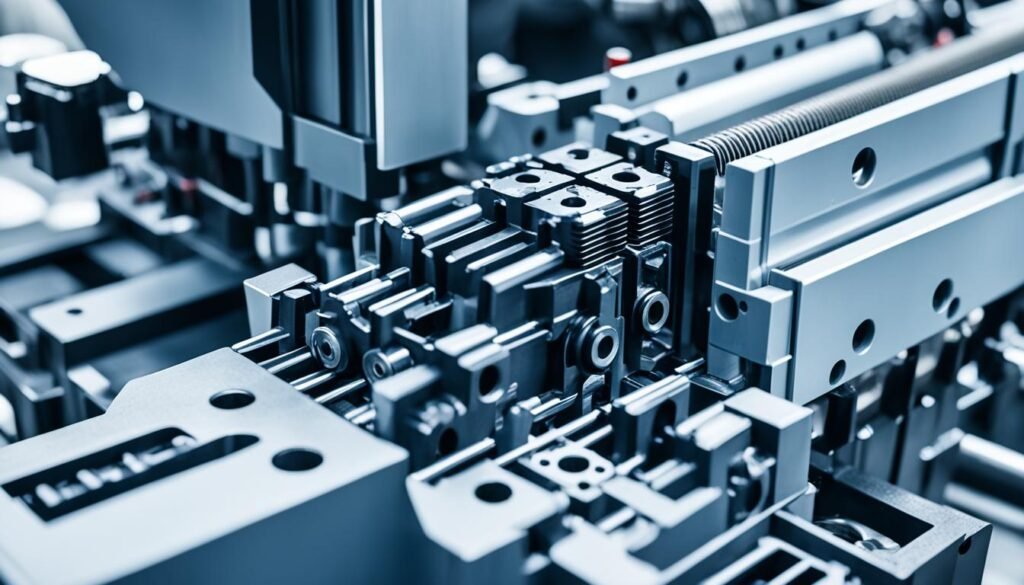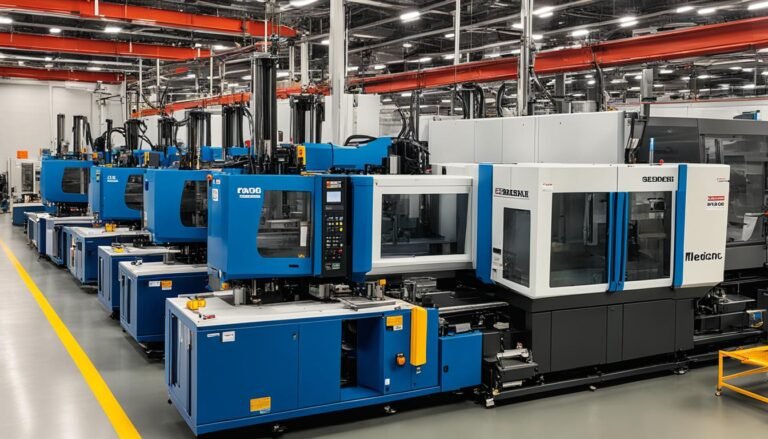As your production needs grow, picking the right THY Precision injection molding machine types is key. It’s important to know the strengths and limits of each machine. This knowledge helps you pick the best equipment for your goals, saving time and money.
We’ll cover the basics of injection molding and the different injection molding machines available. We’ll also look at what to think about when you’re growing your operation. By understanding the design needs of various injection molding machine types, you can make your parts and materials work best together.
Key Takeaways
- Understand the basics of injection molding and how it works
- Explore the diverse injection molding machine types available
- Evaluate production volume and part complexity when scaling up
- Learn how to transition to larger injection molding machine types
- Optimize part design for different injection molding machine types
- Understand the relationship between injection molding machine types and material selection
- Leverage your knowledge to make informed decisions for your business
Understanding the Fundamentals of Injection Molding
THY Precision leads in the injection molding industry. They know how vital it is to master this process. Injection molding makes plastic parts on a large scale. It melts polymer granules and presses them into a mold under high pressure, creating the desired shape.
What is Injection Molding and How Does It Work?
The process starts with an injection molding machine’s key parts: the hopper, barrel, and screw. These work together to melt, mix, and fill the mold with plastic. First, polymer granules go into the hopper. Then, they move to the heated barrel through the screw.
As the plastic heats up, the screw pushes it forward. Finally, it injects the molten plastic into the mold at high pressure. After filling the mold, the plastic cools and hardens, matching the mold’s shape.
This method makes it possible to produce many plastic items efficiently and affordably. Knowing how injection molding machines and the process work is key for growing production or switching between different types of molding.
“Mastering the fundamentals of injection molding is the key to unlocking the full potential of this versatile manufacturing technology.”
Exploring Different Types of Injection Molding Machines
When you look into injection molding, knowing the different machines is key. You’ll find hydraulic, electric, and hybrid machines, each with its own strengths. These strengths can change how well you make parts and how efficient you are.
Hydraulic Injection Molding Machines: Power and Precision
Hydraulic machines use hydraulic power for moving parts and clamping. They’re great for big, complex parts that need a lot of force. But, they use more energy than electric machines.
Electric Injection Molding Machines: Efficiency and Control
Electric machines use motors to control the moving parts. They’re more energy-efficient, quieter, and make parts more consistently. This makes them perfect for detailed and precise parts.
Hybrid Injection Molding Machines: Balancing Power and Efficiency
Hybrid machines mix hydraulic and electric tech. They use hydraulic power for big forces and electric motors for control and efficiency. This mix makes them versatile for many types of parts.
Vertical and Horizontal Injection Molding Machines: Orientation Matters
Injection molding machines come in vertical and horizontal setups. Vertical ones are good for complex parts or specific orientations. Horizontal machines are better for making lots of simple parts.
Rotary Injection Molding Machines: Increased Productivity
Rotary machines have a rotating mold that lets you make many parts at once. This boosts production, making them great for making lots of parts quickly.
Knowing about these different machines is key to growing your business. Think about what you need to make and choose the right machine. This will help you make better products and stay competitive.
Factors to Consider When Scaling Up Injection Molding Operations
When you move to bigger injection molding machine types for scaling up, think about a few key things. The main thing is your production volume. If you’re making more parts, you might need bigger, more powerful machines to keep up.
Also, look at the part complexity. If your parts are very detailed or need tight tolerances, you might need special machines. These machines could have features like multi-cavity molds or better cooling systems. Think about your current and future production volume and part complexity to pick the right injection molding machine types for growing your business.
Evaluating Production Volume and Part Complexity
When scaling up injection molding, keep these points in mind:
- Current and future production volume needs
- How complex your parts are, like their shapes and how precise they need to be
- If you need special features like multi-cavity molds or better cooling systems
- How fast and efficiently you need to produce to keep up
By looking at these important factors, you can pick the best injection molding machine types for your growing business. This will help you smoothly move to making more products.
“Choosing the right injection molding machine types is key when scaling up injection molding operations. Knowing what you need in terms of production volume and part complexity helps you make a smart choice.”
Transitioning to Larger Injection Molding Machine Types
As your injection molding production grows, you might need bigger injection molding machine types. This change needs careful planning to go smoothly. You should think about the space needed, training for your team, and how it affects your molds and tools.
By planning ahead, you can grow your injection molding without losing quality or speed. Here are steps to follow when transitioning injection molding machines:
- Look at your current needs and future growth to pick the right injection molding machine types.
- Check if your space can fit the new machine smoothly.
- Make a training plan for your team to learn about the new injection molding machine.
- Check your molds and tools to see if they need changes for the new machine.
- Work with your supplier to make sure the new injection molding machine installs well.
Thinking about these things helps you move to bigger injection molding machine types smoothly. THY Precision can help you pick the best injection molding machine types for your business.
| Key Considerations for Transitioning Injection Molding Machines | Impact |
|---|---|
| Physical Space and Infrastructure Requirements | Make sure the new machine fits in your space without trouble. |
| Operator Training and Skill Development | Give your team full training to use the new injection molding machine well. |
| Mold Design and Tooling Compatibility | Check and maybe change your molds and tools to work better on the bigger injection molding machine. |
| Collaboration with Equipment Supplier | Work with your supplier for a smooth setup of the new injection molding machine. |

“Successful scaling up of injection molding needs careful planning and doing it right. By looking at the main points, you can move to bigger injection molding machine types easily and keep up with your growing needs.”
Optimizing Part Design for Injection Molding Machine Types
When looking at injection molding machine types, how you design your parts is key. It helps pick the right equipment for your needs. Knowing what each machine can do lets you make parts that work best with it. This makes production smoother and more efficient.
Design Considerations for Different Machine Types
The shape, thickness, and complexity of your parts affect which injection molding machine is best. For parts with small details or tight spaces, an electric injection molding machine is a good choice. It gives precise control. For simple parts made in large quantities, a hydraulic machine might be better.
Parts with complex shapes or thin walls might need an electric injection molding machine. These machines are very precise, making sure each part is the same. But, if you’re making lots of simple parts, a hydraulic injection molding machine could save you money.
| Machine Type | Ideal Part Design Characteristics |
|---|---|
| Electric Injection Molding Machine |
|
| Hydraulic Injection Molding Machine |
|
Matching your part design for injection molding with your injection molding machine types improves production. It cuts down on waste and makes sure parts are top quality. This meets what your customers expect.
“Successful injection molding requires a deep understanding of part design and how it interacts with the capabilities of your production equipment.”
Injection Molding Machine Types and Material Selection
Choosing the right injectionmoldingmachinetypes is key for working with various injectionmoldingmaterials. Different machines have unique features that affect the materials they can handle. It’s important to match the machine with the right material for top-notch parts and efficient production.
When picking an injectionmoldingmachinetype, think about the machine’s pressure and clamping force. Some plastics, like those filled with additives, need more pressure to mold well. On the other hand, simpler plastics can be molded with machines that have lower pressure and force.
Also, consider the machine’s barrel temperature range. Some plastics, like advanced engineering plastics, melt and flow better with higher temperatures. Make sure your machine can reach these temperatures for the best results.
| Injection Molding Machine Type | Suitable Injection Molding Materials |
|---|---|
| Hydraulic Injection Molding Machine | Commodity plastics, filled or reinforced thermoplastics |
| Electric Injection Molding Machine | High-performance engineering plastics, specialty materials |
| Hybrid Injection Molding Machine | Wide range of thermoplastic materials, including high-performance and specialty options |
Matching your injectionmoldingmachinetypes with your injectionmoldingmaterials boosts your production. It improves part quality and makes your injection molding more efficient.

Conclusion
When you’re growing your injection molding operation, picking the right machine types is key. Knowing how injection molding works and the different machines out there helps you scale up smoothly. You need to think about how much you’re making and the complexity of your parts to pick the best machines.
Improving your part design for your machine and choosing the right materials boosts your process’s efficiency and cuts costs. Whether you’re moving up to bigger machines or adding special ones, plan carefully. Think about your goals and what your machines can do.
Learning to switch between different injection molding machines sets your THY Precision business up for success. With the right gear and knowledge, you can grow your production to meet market needs. This keeps you ahead in the competition.

